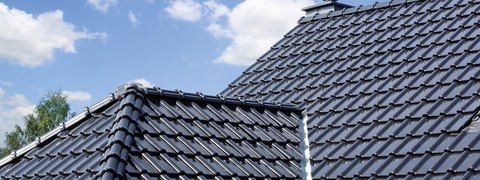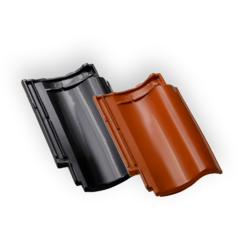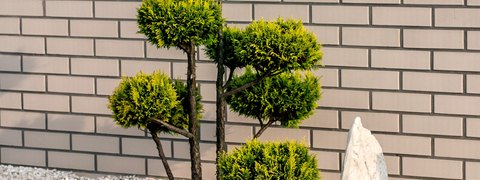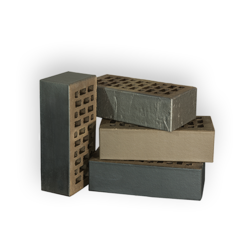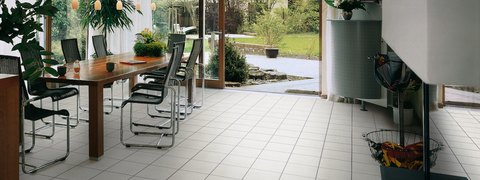Unfortunately, we do not sell our products to individual customers, you can buy them at the building wholesalers who cooperate with us (a contact list is available on our website in the section “Where to buy” – just select the province and the city, and the list of wholesalers will appear). Please contact the selected sales point directly and it will provide a free quote of the roof covering on the basis of the roof design. You can check estimated gRoss market prices in the price list placed in the section “Materials to download – price list of roof tiles and accessories”. Please remember that the price of the roof will depend on the tile type and the chosen colour, as well as its complexity – the more surface area, dormers, valleys, etc., the more expensive the roof will be because you need more accessories, such as ridge tiles or extreme roof tiles, etc. for its proper finishing.
Growing of the moss on the roof tiles is a natural process, especially in shady, damp places on the north side. If it is bothersome for aesthetic reasons, we advise you to spray these areas with moss and algae killer solutions available in agricultural and gardening shops. When the preparation starts to work and the roof surface dries off (the moss will turn brown), wash the area with a pressure washer. Then, you can spray the tiles with the same solution again, which will minimize the risk of further moss growth. We recommend hiring a professional roof cleaning team to perform these activities.
Snow may get under the tile. This happens on every roof during heavy rain and wind. This is a completely normal situation in our local climate. What is more, apart from snow, also dust or rain can also get under the roof tiles. None of them, however, can permeate the layers under the tiles. As a rule of thumb, the roof must be tight before the roof tiles are laid, it cannot leak anywhere. Roof tiles are designed to give it durability, protect against UV rays; and of course, they also have an aesthetic function.
However, it is the task of waterproofing accessories, i.e. foil, boarding and / or roofing paper, to prevent the water from coming under the tiles. The entire roofing system, covering both the roof tiles and the area underneath, is designed to complement and comprehensively ensure waterproofness, longevity, aesthetics and other desirable features. The abovementioned features of the roofing and waterproofing are discussed e.g. in such publications as "Ceramiczne pokrycia dachowe. Szczegóły wykonawcze" (Eng. Ceramic roofing. Construction details) and "Roof Construction Manual. Pitched roofs".
The "Roof Construction Manual" is the English edition of the well-known German publication Dachatlas, which describes the issue of the undercoating and pressures that the roofing is subject to: "Roofs covered with small elements are resistant to rain due to the large proportion of joints, but they are not waterproof (...) Volatile snow and lashing rain can be blown through the joints of the cover. When the roof is gently pitched, the wind may blow the rainwater up the roof surface and push it through the joints into the interior. The penetration of snow and rain through supply and exhaust openings is inevitable." Therefore, laying a foil is a very important issue that has a key impact on the tightness of the roof and its non-leakage. The foil cannot be torn. In the case of single-layer foils, holes in the membrane may be formed when hammering down counter battens. Three-layer foils tend to cover such holes, and the water does not leak as a result. Therefore, if an investor chooses a single-layer foil, additional gaskets should be attached in the places where the counter-battens are hammered. Another important issue that must not be forgotten in the context of protection against leakage is the proper arrangement of the foil around the chimney. At this point, the membrane should be turned up and additionally secured. If the roof does not leak, the snow that gets under the tiles is nothing to worry about. However, if the water penetrates the walls and gets into the interior of the house, it means that the waterproofing (undercoat) is leaking and you should consult an expert or an experienced roofer on how to counteract it. It is worth noting that first of all, you should take care of a special type of undercoat (preferably a roof covered entirely with roofing paper) when: the attic is usable, the roof has a small inclination angle, and the weather conditions include strong wind, rain and heavy snowfall (e.g. in the mountains on an exposed surface).
We determined the recommended and minimum inclination angle for each of the roofing systems we manufacture. For example – the recommended roof inclination angle for Piedmont tiles is up from 22 degrees, and the minimum – 16 degrees. This means that in the case of a roof with an inclination between 16 and 22 degrees, it is necessary to provide full boarding with waterproofing (roofing paper), because due to the small angle, water and snow may lie on the roof so it should be additionally protected against leakage. Using full boarding with roofing paper is also recommended also if there are frequent strong winds in the place where the house is located, it has a usable attic and is situated in an exposed space. In this case, full boarding with roofing paper provides greater tightness and resistance to difficult weather conditions. If the roof has an inclination angle from 22 degrees, the Piedmont and MONZAplus tiles can be placed without using so-called additional protection in the cover, i.e. directly on the membrane (roofing foil). For the Bornholm tile, the recommended inclination angle is 30°.
The spacing of battens varies for particular types of roof tiles we produce:
Piemont – 365-403 mm / MONZAplus – 390-396 mm / Bornholm – 363-369 mm / Fleming – 363-369 mm
Please keep in mind that it is always recommended to lay tiles with medium batten spacing (e.g. for the MONZAplus tiles, it is 393 mm). All technical parameters, including the spacing of battens for individual tiles, can be found in the publication "Ceramic roof" in the download section – Röben catalogues.
The general principle of arrangement is that one ventilation roof tile should be placed on an average of 13 m2 of the roof. If the roof edge is shorter than 6-7m, there is no need to use ventilation tiles on the roofing – they are necessary only in sensitive places with difficult ventilation, e.g. near roof windows. In turn, on roofs with an edge longer than 7 m, it is a standard practice to arrange the vent roof tiles in the third row under the ridge.
More information on roof ventilation and vent roof tiles can be found in the download section – information sheets – roof.
When it comes to calculating how many roof tiles should be purchased, please contact any wholesaler cooperating with us, they will do it free of charge – the list of addresses is available in the section “Where to buy Röben products?”
This solution is incorrect. We have two types of pipes in our offer: air vent (two types) and ventilation. The Röben air vent pipe is used to vent the sewage system. Its role for the proper operation of this installation is very important, because the sewage system functions properly only when it is effectively ventilated. The basic function of the Röben ventilation pipe is the ventilation of rooms – it can be used as the end of the ventilation installation of e.g. bathroom, garage or kitchen. Thus, this type of a pipe should be used at the end of the hood. You can read more about air vent and ventilation pipes in the download section – Information sheets – roof.
The colour and finishing of the roof are obviously a matter of taste, but it is worth to pay attention to the similarities and differences between engobed and naturally. finished tiles. All parameters regarding strength, absorbability and resistance to weather conditions are similar.
However, the engobe surface is smoother (more slippery) than the natural surface, which makes it more resistant to the deposition of pollutants, pollen, algae etc. If you plan to build a house in a shady place close to trees, it is worth considering the engobe or glazed tiles. As you say, engobe delays growing moss, while glazed tiles are susceptible to growing moss.
A special paint in the colour of the tile surface (the so-called cold engobe) is used to paint the places where the roof tiles are cut. It is available at every wholesaler offering our products.
The specificity of ceramic firing causes that despite the electronically controlled technological process, computer quality control and colour repeatability, there may be slight differences in colour. The reason is the basic natural raw material used for the production, i.e. clay.
This is also described in the Polish Standard – PN-EN 1304: 2002 / Ap1: 2004 Ceramic roof tiles – Product definitions and specifications; Annex B on page 16 APPEARANCE AND CONSTRUCTION. "In the case of one-colour roofs, differences in hue shades are possible, resulting from specific methods of the production process of ceramic products." With a long interval in the production of tiles, colour differences can occur. In this case, we recommend to use the tiles with a different shade to cover e.g. canopies over dormers. Then, the colour differences will not be visible.
The layer of glaze or engobe is very durable, it has a 30-year warranty.
If the shell of the outer roof tile the engobe or glaze flakes or peels as a result of cracks (and this is not caused by violent weather conditions, such as hail), this product is subject to complaint as faulty. However, hairline or micro-cracks on the surface of engobe cannot be the subject of a complaint. They appear on the visible layer of engobe or enamel and are formed as a result of intensive reduction on the glazed surfaces. They do not reduce the adhesion of engobe and enamel and have no negative effect on the performance of the tile. Their natural occurrence on ceramics is described in the Polish Standard PN-EN 1304 “Roof tiles and ceramic fittings. Product definitions and specification.”
